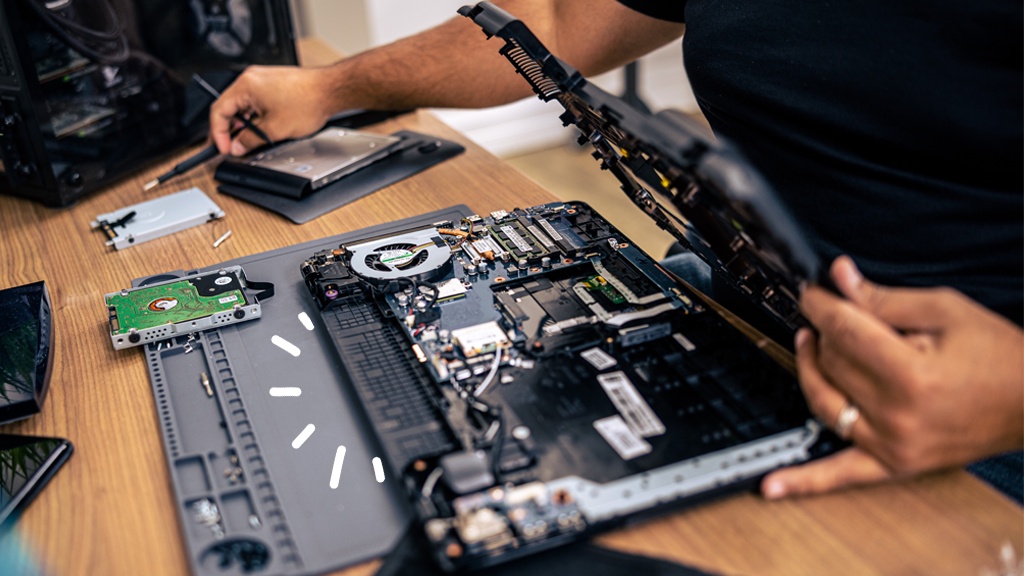Laptops are marvels of modern technology, but even the most sophisticated machines can hiccup from time to time. A sluggish performance, overheating issues, or a malfunctioning keyboard can disrupt your workflow and leave you feeling frustrated. Before you rush to the repair shop and face potentially hefty bills, consider some simple DIY fixes you can attempt at home. These solutions are designed to be safe and effective, potentially saving you time and money. However, it's important to remember your limitations. If you're unsure about any step, consulting a professional is always the best course of action.
The Importance of Basic Laptop Repair Skills
Learning basic laptop repair skills empowers you to troubleshoot common issues and potentially extend the lifespan of your device. Enrolling in a reputable laptop repairing institute in Delhi like Hi-Tech Institute can equip you with the knowledge and confidence to tackle these simple fixes. Hi-Tech Institute boasts over 20 years of experience and has trained over 3 lakh students, making them a leader in the field. With the growing demand for skilled professionals in the laptop repair industry - estimates suggest a need for over 18 lakh engineers - these skills could even translate into a lucrative side hustle, potentially earning you an additional Rs. 40,000 to Rs. 50,000 per month.
8 Easy DIY Laptop Fixes You Can Do at Home
Now, let's dive into eight simple DIY laptop repairs you can attempt at home, with minimal risk involved.
1. Reboot and Power Cycle: This might seem like a no-brainer, but it's surprisingly effective. A simple restart can often clear temporary glitches and memory issues that cause sluggish performance. If a restart doesn't solve the problem, try a full power cycle. Shut down your laptop completely, unplug it from the power source, and remove the battery (if possible). Hold down the power button for 30 seconds, then re-insert the battery (if applicable) and plug your laptop back in. Power it on and see if the issue persists.
2. Declutter Your Desktop and Files: Over time, your desktop and storage drives can become cluttered with unused files, programs, and temporary data. This clutter can slow down your laptop's performance. Take some time to organize your files, uninstall unused programs, and empty your recycle bin. You can also utilize built-in disk cleanup tools to remove unnecessary temporary files.
3. Manage Startup Programs: Many programs automatically launch when you start your laptop, which can slow down the boot process and consume valuable system resources. Review your startup programs and disable any applications you don't need running in the background. This can be done through your task manager settings.
4. Update Drivers and Software: Outdated drivers and software can lead to compatibility issues and performance problems. Make sure you have the latest updates installed for your operating system, device drivers (graphics card, sound card, etc.), and any software you use regularly. Most updates can be downloaded and installed automatically through your system settings.
5. Dust Out Your Laptop: Dust buildup inside your laptop can restrict airflow and lead to overheating, which can damage internal components and cause performance issues. Carefully open your laptop's back panel (consult your user manual for specific instructions) and use a compressed air can to blow out any dust bunnies. Important Note: Before opening your laptop, ensure it's completely powered down and unplugged.
6. Check for Overheating: If your laptop feels unusually warm, it could be overheating. This can be caused by dust buildup (addressed in point 5), a malfunctioning fan, or even a blocked air vent. Identify the source of the heat and take corrective action. If the issue persists, it's best to consult a professional.
7. Optimize Power Settings: Most laptops offer various power management options. Adjusting these settings can improve battery life or optimize performance depending on your needs. For example, you can switch to a power-saving mode for extended battery life or a high-performance mode for demanding tasks.
8. Invest in a Cooling Pad: If you find your laptop frequently overheating, even after cleaning it, consider investing in a cooling pad. These external pads provide additional ventilation and can help regulate your laptop's temperature during extended use.
Conclusion:
By following these simple DIY fixes, you can potentially troubleshoot common laptop issues and keep your machine running smoothly. Remember, if you're ever unsure about a particular step, don't hesitate to consult a professional or consider enrolling in a laptop repairing course in West Delhi. Institutes like Hi-Tech Institute can equip you with the knowledge and skills to tackle more complex repairs and potentially open doors to a rewarding career path in the laptop repair industry.
Remember: A proactive approach to laptop maintenance can save you time, money, and frustration in the long run. Equipping yourself with basic repair skills empowers you to take control of your device's health and potentially prevent minor problems from escalating into expensive repairs.


No comments yet